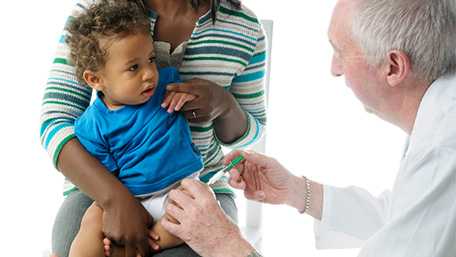Key Findings: Invasive Pneumococcal Disease among Children with and without Sickle Cell Disease in the United States, 1998-2009

Did you know…
- Up to 1.6 million people die each year globally as a result of pneumococcal disease?
- Approximately 10% of all patients with invasive pneumococcal disease die of their illness?
- Vaccination (getting a shot) is the best way to prevent pneumococcal disease?
CDC Study Published
The journal Pediatric Infectious Diseases has published a CDC study that looks at trends, hospitalizations, death rates, and types of bacteria strains among children with sickle cell disease compared with other children.
Sickle cell disease is a group of inherited red blood cell disorders in which the red blood cells become hard and sticky and look like a C-shaped farm tool called a “sickle.” The sickle cells die early, which causes a constant shortage of red blood cells. Also, when they travel through small blood vessels, they get stuck and clog the blood flow. This causes pain and other serious problems such as infection, acute chest syndrome and stroke.
Previous studies have found that giving pneumococcal conjugate vaccine (PCV7) has reduced the rate of invasive pneumococcal disease (IPD) among healthy children who are not at increased risk for IPD, as well as among children with SCD (who are at increased risk for IPD). This new CDC study supports these same findings. In addition, it highlights the difference in risk for IPD between children with SCD and children who are otherwise healthy. In spite of the availability of the pneumococcal conjugate vaccine, children with SCD still tend to be more affected by IPD than children without SCD. You can read the article’s abstract here.
What is Pneumococcal Disease?
An infection caused by a certain type of bacteria, known as pneumococcus. It can result in illnesses like pneumonia (a lung infection), infection of the blood, middle ear infection, or meningitis (an infection of the membranes covering the brain and spinal cord).
What are the two main types of pneumococcal disease?
Invasive pneumococcal disease (IPD)
- Is usually very severe and occurs in parts of the body that normally don’t have any bacteria present, like the bloodstream or membranes surrounding the brain and spinal cord.
Non-invasive pneumococcal disease
- Tends to be less serious than IPD and occurs in parts of the body that often get exposed to germs, like the ears and sinuses.
Why get vaccinated with pneumococcal conjugate vaccine (PCV)?
- Vaccination (getting a shot) is the best way to prevent pneumococcal disease.
- There are 91 strains (types) of pneumococcal bacteria.
- PCV7 protected against 7 of these strains. PCV13 (licensed in 2010) protects against 13 of these strains. The strains that are covered by the vaccine are responsible for most severe pneumococcal infections among children.
- The pneumococcal polysaccharide vaccine (PPSV23) is also recommended for children with SCD.
Main Findings from this Study
- Rates of IPD among children younger than 18 years of age with SCD dropped 53% after PCV7 was first introduced in 2000.
- Rates of IPD among children with SCD remain higher than the overall rate among African-American children.
- Children with SCD and IPD were more likely to be hospitalized and more likely to die as a result of their infection than otherwise healthy children with IPD.
Take Home Messages from this Study
- Children with SCD should be immunized (given shots) according to the recommended immunization schedule for children with conditions that make their bodies less capable of fighting off infection.
- Children with SCD should receive a daily dose of penicillin, an antibiotic medicine, to help prevent infections until the child is at least 5 years of age.
- More research on better prevention strategies is needed to reduce the higher risk of IPD among children with SCD compared to otherwise healthy children.
CDC Activities
CDC’s National Center on Birth Defects and Developmental Disabilities (NCBDDD), Division of Blood Disorders (DBD) considers SCD a major public health concern and is committed to monitoring the numbers of people affected by this condition, raising awareness, and promoting health education. Highlighted below are select activities that showcase CDC’s work on this important topic:
- Collaborating with CDC’s National Center for Immunization and Respiratory Diseases (NCIRD), Division of Bacterial Diseases to assess the impact of pneumococcal conjugate vaccine among children with SCD.
- Analyzing information that was collected from seven states that participated in the Registry and Surveillance for Hemoglobinopathies (RuSH) project. This two year project identified unique ways to gather the information needed to learn more about people with SCD from multiple data sources.
- Carrying out the Public Health Research Epidemiology and Surveillance for Hemoglobinopathies (PHRESH) project in California, Georgia and Mississippi, which will strengthen and improve upon the information gathering strategies developed in RuSH to help better understand SCD and the healthcare needs of those with SCD.
- Learning what information is needed to increase the public’s and healthcare providers’ awareness and knowledge about SCD and how best to share the information.
- Hosting an ongoing monthly public health webinar series to raise awareness among healthcare professionals, public health staff, patients, and others.
More Information
To learn more about pneumococcal disease, please visit: www.cdc.gov/pneumococcal/
To learn more about pneumococcal vaccination, please visit: https://www.cdc.gov/vaccines/vpd-vac/pneumo/vac-faqs.htm
To learn more about sickle cell disease, please visit https://www.cdc.gov/ncbddd/sicklecell/.
Paper Reference
Payne AB, Link-Gelles R, Azonobi I, Hooper WC, Beall BW, Jorgensen JH, Juni B, Moore M. Invasive pneumococcal disease among children with and without sickle cell disease in the United States, 1998-2009. Pediatr Infect Dis J. 2013. Jul 9. [Epub ahead of print].
- Page last reviewed: August 9, 2017
- Page last updated: February 9, 2015
- Content source:


 ShareCompartir
ShareCompartir